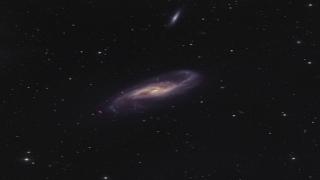Bibcode
Borlaff, Alejandro S.; Lopez-Rodriguez, Enrique; Beck, Rainer; Clark, Susan E.; Ntormousi, Evangelia; Tassis, Konstantinos; Martin-Alvarez, Sergio; Tahani, Mehrnoosh; Dale, Daniel A.; del Moral-Castro, Ignacio; Roman-Duval, Julia; Marcum, Pamela M.; Beckman, John E.; Subramanian, Kandaswamy; Eftekharzadeh, Sarah; Proudfit, Leslie
Referencia bibliográfica
The Astrophysical Journal
Fecha de publicación:
7
2023
Revista
Número de citas
29
Número de citas referidas
21
Descripción
We present the analysis of the magnetic field (B-field) structure of galaxies measured with far-infrared (FIR) and radio (3 and 6 cm) polarimetric observations. We use the first data release of the Survey of extragALactic magnetiSm with SOFIA of 14 nearby ( $\lt 20$ Mpc) galaxies with resolved ( $5^{\prime\prime} \mbox{--}18^{\prime\prime} ;$ 90 pc-1 kpc) imaging polarimetric observations using SOFIA/HAWC+ from 53 to 214 μm. We compute the magnetic pitch-angle ( ${{\rm{\Psi }}}_{B}$ ) profiles as a function of the galactocentric radius. We introduce a new magnetic alignment parameter (ζ) to estimate the disordered-to-ordered ratio of spiral B-fields. We find FIR and radio wavelengths to not generally trace the same B-field morphology in galaxies. The ${{\rm{\Psi }}}_{B}$ profiles tend to be more ordered across all galactocentric radii in radio ( ${\zeta }_{6\mathrm{cm}}\,=\,0.93\pm 0.03$ ) than in FIR ( ${\zeta }_{154\mu {\rm{m}}}=0.84\pm 0.14$ ). For spiral galaxies, FIR B-fields are 2%-75% more turbulent than the radio B-fields. For starburst galaxies, we find that FIR polarization is a better tracer of the B-fields along the galactic outflows than radio polarization. Our results suggest that the B-fields associated with dense, dusty, turbulent star-forming regions (those traced at FIR) are less ordered than warmer, less dense regions (those traced at radio) of the interstellar medium. The FIR B-fields seem to be more sensitive to the activity of the star-forming regions and molecular clouds within a vertical height of a few hundred parsecs in the disk of spiral galaxies than the radio B-fields.
Proyectos relacionados

Las Galaxias Espirales: Evolución y Consecuencias
Nuestro grupo pequeño esta bien conocido y respetado internacionalmente por nuestro trabajo inovativo e importante en varios aspectos de la estructura y la evolución de las galaxias espirales cercanas. Usamos principalmente observaciones en varias longitudes de onda, explotando las sinergías que nos permiten responder a las cuestiones más
Johan Hendrik
Knapen Koelstra